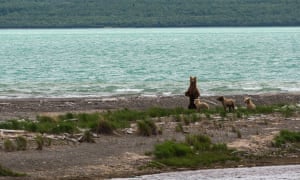More than 2,000 bears live within Katmai national park in Alaska, where they spend the precious few warm-weather months fishing for salmon, swimming and strolling over the park’s nearly 4.1m acres. But in recent years, one bear has cultivated an internet following for demonstrating uncommonly aggressive behavior with others.
Meet Grazer, a 15-year-old sow, and arguably one of the most easily recognizable animals on the park’s Bear Cam, which live-streams footage of the park’s brown bears from early summer to just before hibernation. With a light blond coat, a long, straight muzzle and large, conspicuous ears not unlike pom-poms, she’s easy to pick out, and something of a celebrity; a clip of her chasing after her cubs after they rode the current over a waterfall garnered 1.8m views and nearly 28,000 shares on Facebook, and loyalists have gone as far documenting her life history on a fandom wiki.
Grazer is a particularly defensive mother – something that’s mystified park rangers over the years. She had cubs earlier this year – but her behavior goes back to 2016, according to park rangers who worked there at the time, when she reared her first litter of three. While other mother bears will be more discreet about removing their cubs from potentially dangerous situations, Grazer is quick to go on the offensive, pre-emptively attacking other bears, even the largest adult males.
“It really seems like almost any bear that looks at her the wrong way, she will charge,” said Mike Fitz, a former ranger at Katmai who now works for explore.org, monitoring the animal-viewing webcams. Fitz worked closely with the bears at Katmai from 2007 – when Grazer was a two-year-old and still hanging out with her mother – through 2016, when Grazer’s first litter was born.
Amber Kraft, the interpretation and education program manager for Katmai national park, echoed Fitz, saying, “Grazer proved to be remarkably protective of her first litter” and that she was displaying the same temperament with this batch.

While Grazer’s behavior may sound unnaturally hostile or potentially hazardous, Kraft says it is not so unheard of that it is cause for concern. Mother bears are known for being defensive, Kraft says, but “as a more dominant female, Grazer displays a more offensive nature”.
This often manifests in Grazer charging and roaring at bears she thinks are intruding on her family’s space. If the offender doesn’t move away quickly enough, she’ll attempt to maul them, swatting and biting at their faces.
Cubs, particularly first-year cubs, are vulnerable to a variety of threats, not the least of which is other bears. Fitz said a high level of defensiveness may have evolved in mother bears to reduce cub mortality, which could explain Grazer’s behavior. It could also be a case of immediate gratification – every time she’s successful at defending her space it gives her the confidence to do it again.
“Her behaviors aren’t things that we don’t see in other bears, but she seems to exemplify defensiveness more than other female bears at Brooks River,” said Fitz. “Exhibiting those behaviors allows Grazer to occupy these fishing spots that other females can’t access.”
Grazer’s apparently fearless attitude can be seen at one of the park’s waterfalls – a densely packed fishing spot on the Brooks River. In peak summer, hundreds of salmon are airborne every minute, causing a feeding frenzy. Because tensions can run high there, not all females will take their cubs near the falls and will instead opt to fish in less competitive spots downriver or will scavenge.
Grazer, however, likes to fish directly on the lip of the falls (sometimes with her cubs, sometimes without), where the concentration of salmon is highest. While not unheard of, this behavior does set her apart from other female bears.

Officially, Grazer is known by her identification number #128 – she’s one of few bears at Katmai national park to have received a nickname.
Grazer earned her moniker years ago, according to Fitz, after a co-worker noticed she was frequently grazing on vegetation as a sub-adult. But now her nickname is more a verb, at least among hardcore fans of the park’s bear cam, who refer to her physical encounters with other bears as getting “Grazered”.
“You can almost predict that some bears are going to get charged by her,” Fitz said.
Contrary to popular belief, bears don’t want to fight. They’d rather prepare for hibernation and a successful winter. Bears recognize each other and their varying places in the hierarchy help them avoid conflict. And size can become shorthand for bears’ reputation: often when two of the largest bears at Katmai, known as #856 and #747 approach the waterfall, the other bears will instinctively move out of their way.
Still, disposition plays a big role in the hierarchy, as well. Bears with more aggressive and assertive demeanours (and the fighting skills to back it up) are sometimes able to leapfrog over larger bears in the ranking system. Because Grazer is so reactive, she’s on a level other females and many males will probably never reach.
It’s too early to say if any of Grazer’s cubs will exhibit similar defensive behaviors to their mother or if they’ll be mellower. For now, Grazer’s biggest concern is raising healthy cubs – by any means necessary.
“We’ve been able to witness that maternal connection, that bond between mother and cub,” Fitz said. “Cubs make this reverberating noise when they’re feeling contentment and when they’re nursing. It’s kind of like purring, but sounds more like a car engine that won’t start. That stands out in my mind. Not just her defensiveness, but also her tenderness with her cubs.”